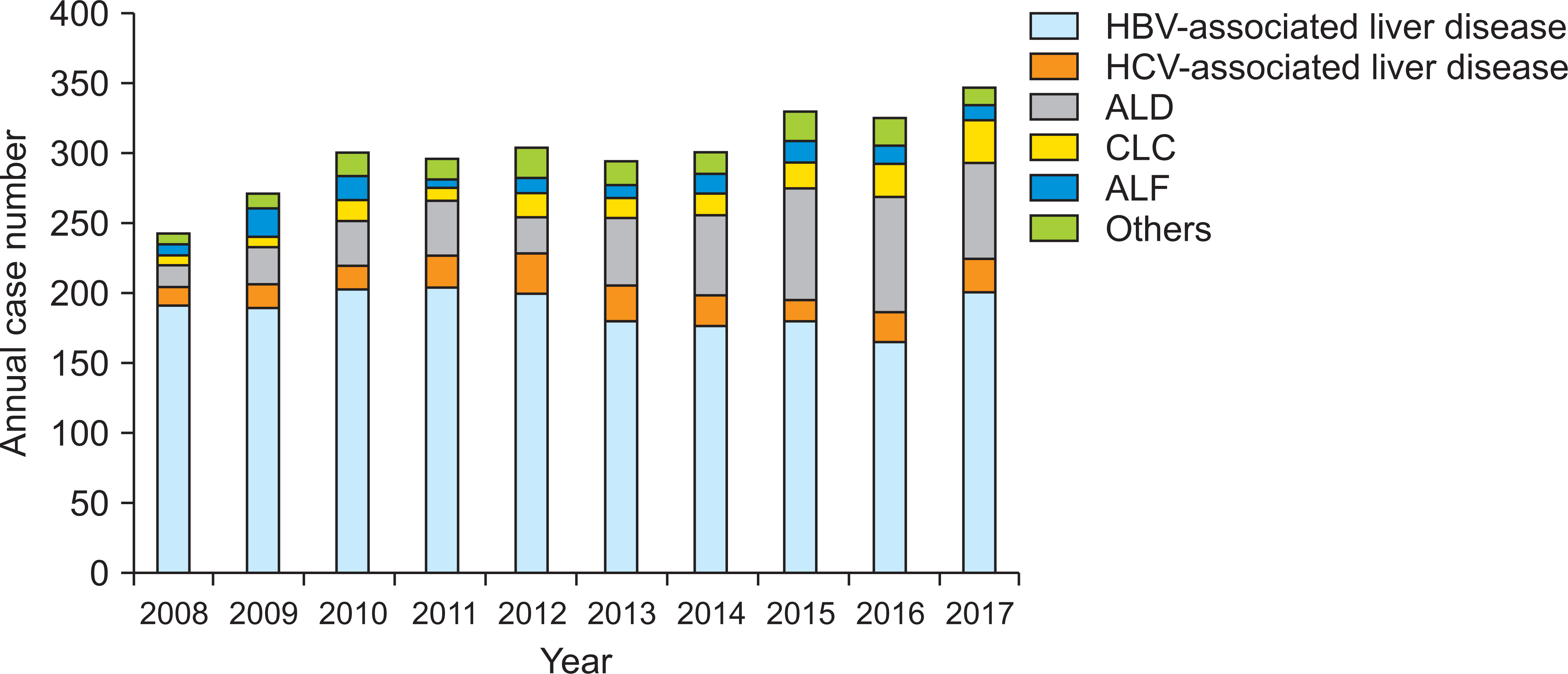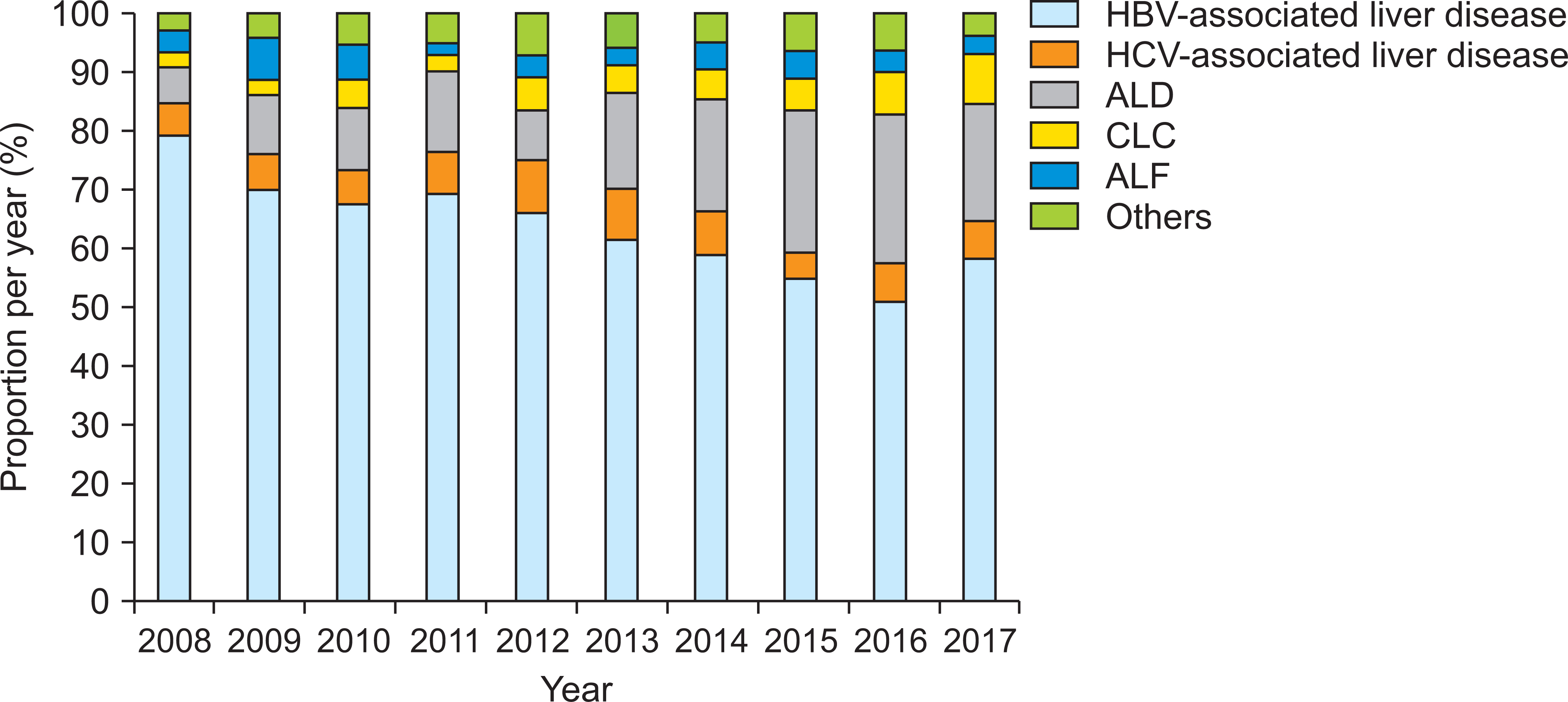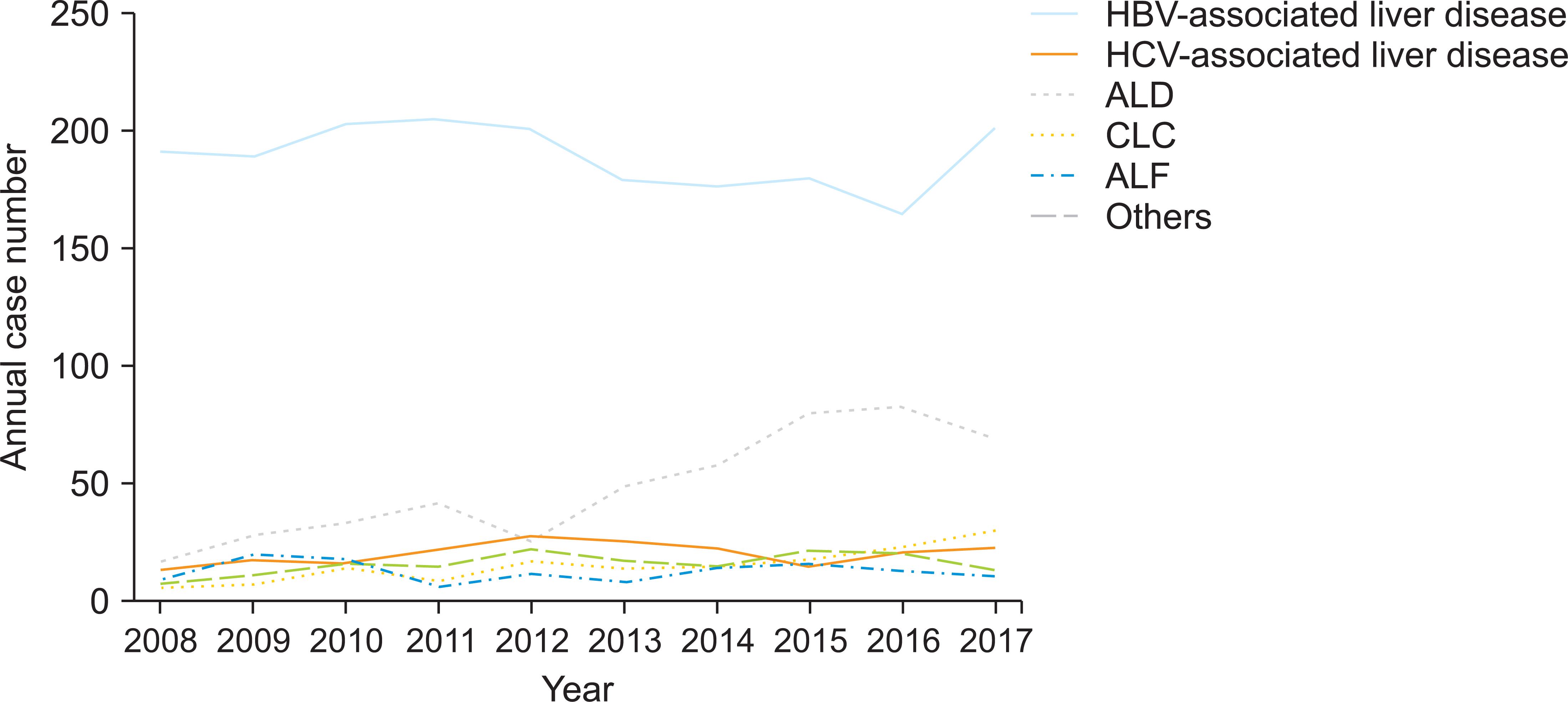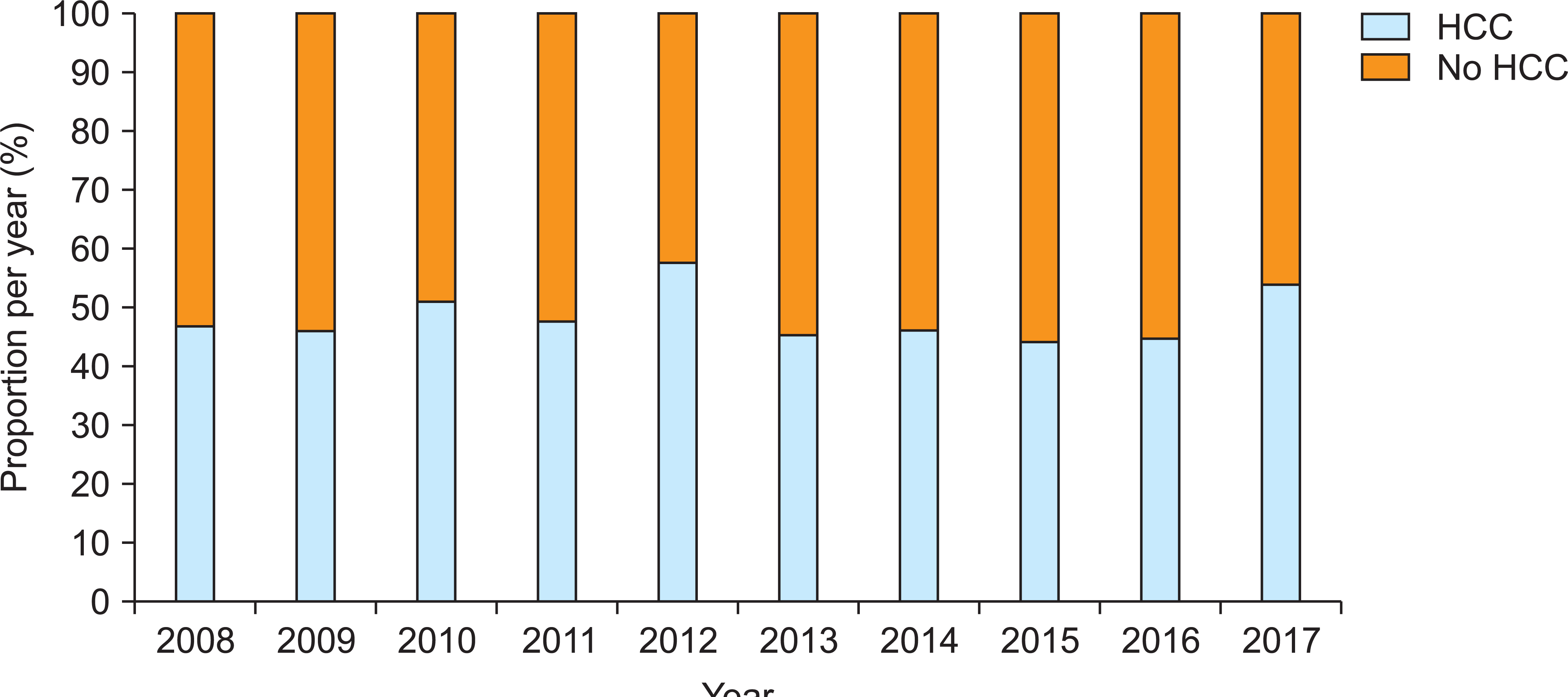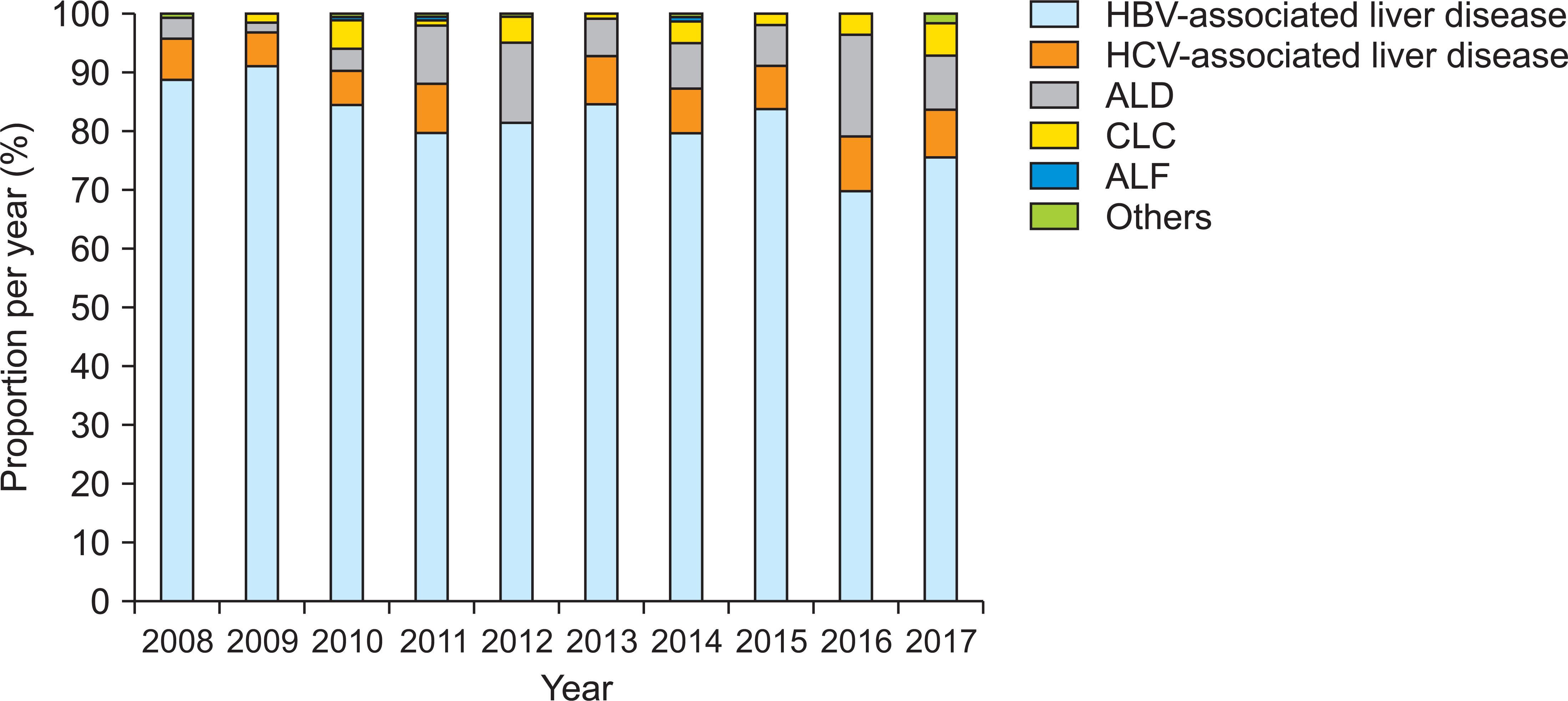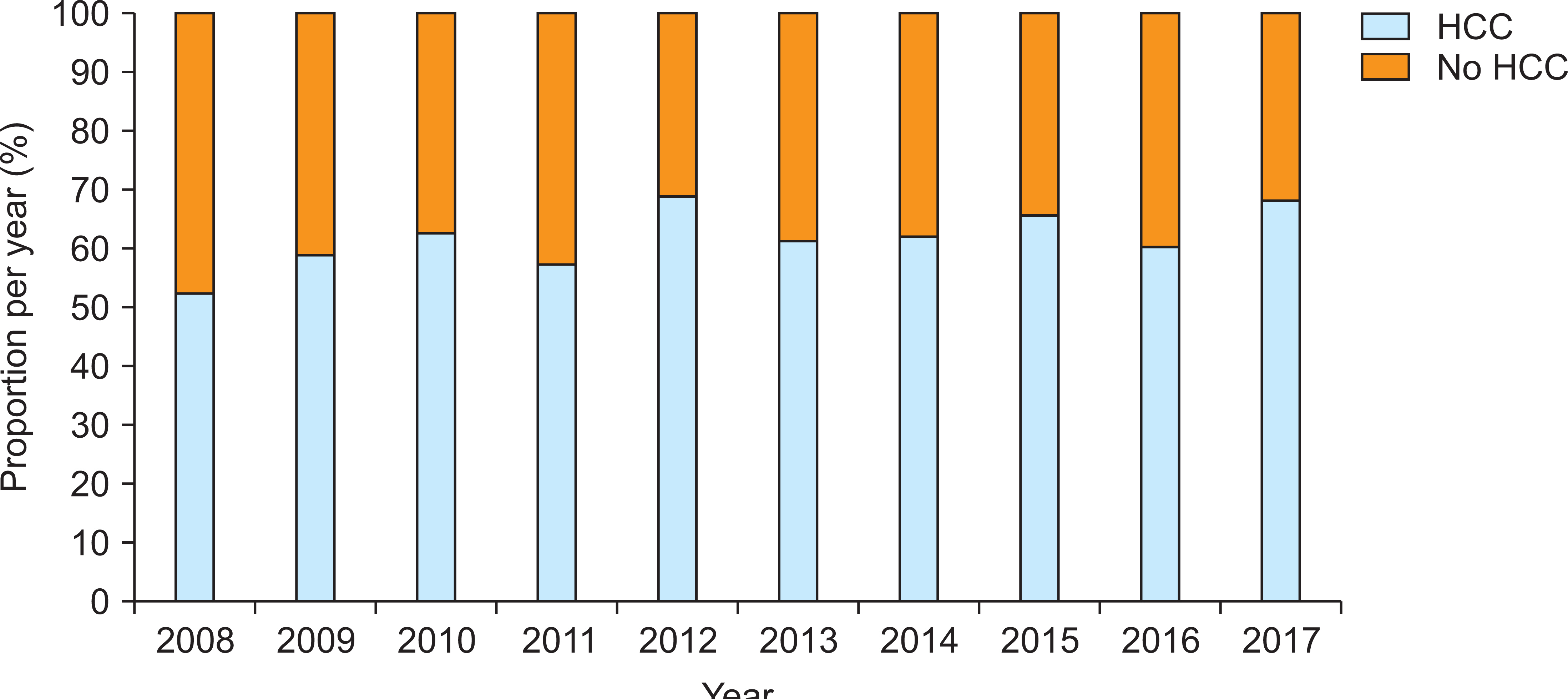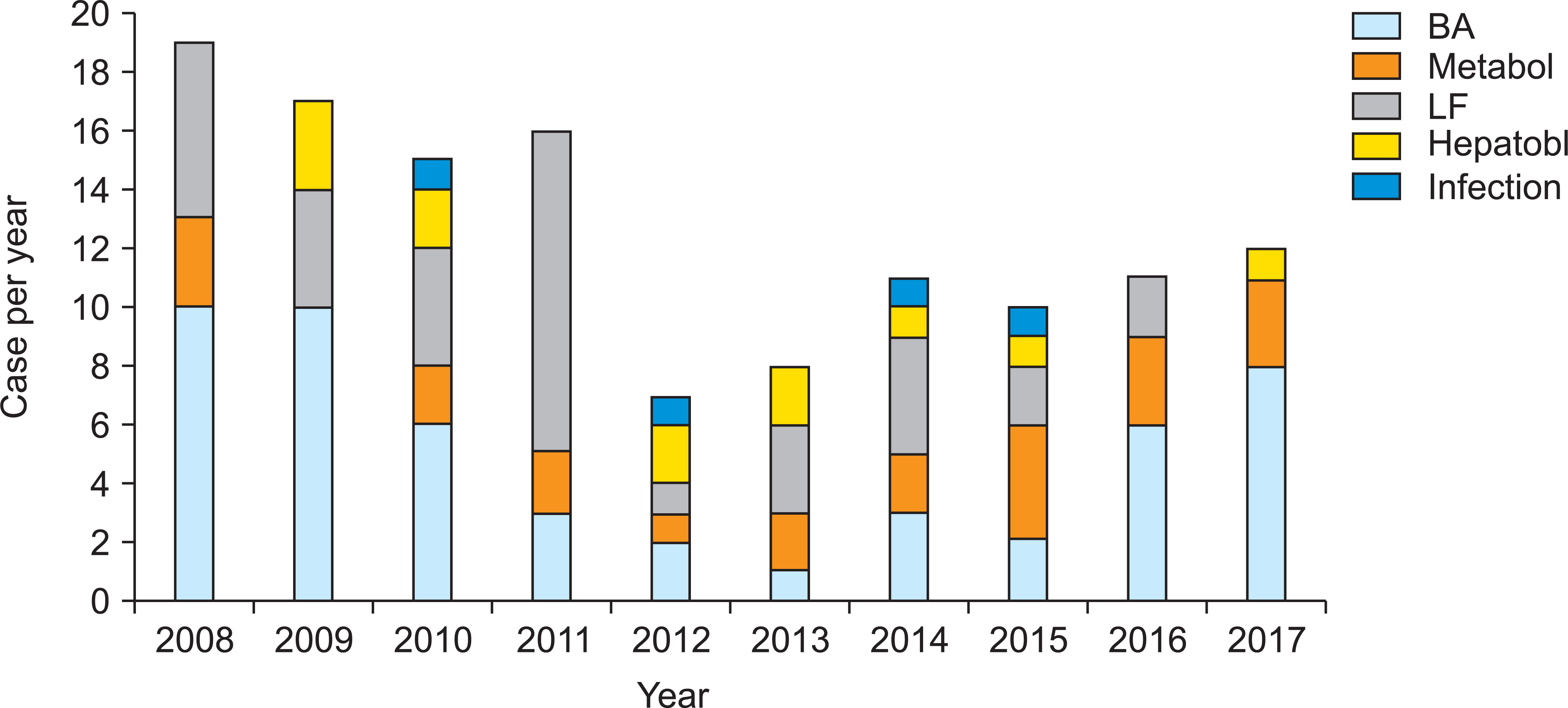Korean J Transplant.
2020 Mar;34(1):47-54. 10.4285/kjt.2020.34.1.47.
Changes in the indications for living donor liver transplantation: single-institution experience of 3,145 cases over 10 years
- Affiliations
-
- 1Department of Surgery, Asan Medical Center, University of Ulsan College of Medicine, Seoul, Korea
- KMID: 2503782
- DOI: http://doi.org/10.4285/kjt.2020.34.1.47
Abstract
- Background
To understand the changing demands and recent trends in the indications for living donor liver transplantation (LDLT), the present study aimed to analyze the indications for LDLT performed in a high-volume transplantation center over 10 years.
Methods
The liver transplantation database at our institution was searched to identify patients who underwent LDLT during a 10-year period from January 2008 to December 2017. The study subjects (n=3,145) were divided into two groups: adult patients (n=3,019, 92.7%) and pediatric patients (n=126, 3.9%).
Results
In the adult recipients, the primary diagnoses were hepatitis B virus (HBV)- associated liver cirrhosis (n=1,898, 62.9%), alcoholic liver disease (n=482, 16.0%), hepatitis C virus-associated cirrhosis (n=203, 6.7%), acute liver failure (n=127, n=4.2%), and other diseases (n=157, 5.2%). The mean Model for End-Stage Liver Disease score was 15.6±8.8 (range, 6–40). The proportion of patients with HBV-associated liver disease gradually decreased, but the proportion of those with alcoholic liver disease increased. Hepatocellular carcinoma (HCC) was diagnosed in 1,467 patients (48.6%). The mean proportion of patients with HCC was 63.1% among those with HBVassociated liver disease. In pediatric recipients, the primary diagnoses were biliary atresia (n=51, 40.5%), liver failure of various causes (n=37, 29.4%), metabolic disease (n=22, 17.5%), hepatoblastoma (n=12, 9.5%), and infectious diseases (n=4, 3.2%).
Conclusions
Our results showed that there were some significant changes in the indications of LDLT. We believe that our results may reflect the real changes in the indications of LDLT and they will be useful for predicting further changes in the future.
Keyword
Figure
Cited by 1 articles
-
Chronological improvements of living donor liver transplantation for hepatocellular carcinoma in Seoul National University Hospital
Saran Ochir Gongor, Kwang-Woong Lee, Nam-Joon Yi, YoungRok Choi, Suk Kyun Hong, Jeong-Moo Lee, Jae-Yoon Kim, Kyung-Suk Suh
Ann Liver Transplant. 2024;4(2):71-79. doi: 10.52604/alt.24.0008.
Reference
-
Lee SG., Moon DB., Hwang S., Ahn CS., Kim KH., Song GW, et al. 2015. Liver transplantation in Korea: past, present, and future. Transplant Proc. 47:705–8. DOI: 10.1016/j.transproceed.2015.02.015. PMID: 25891715.
ArticleHa SM., Hwang S., Song GW., Ahn CS., Moon DB., Ha TY, et al. 2017. Successful introduction of Model for End-stage Liver Disease scoring in deceased donor liver transplantation in Korea: analysis of first 1 year experience at a high-volume transplantation center. Ann Hepatobiliary Pancreat Surg. 21:199–204. DOI: 10.14701/ahbps.2017.21.4.199. PMID: 29264582. PMCID: PMC5736739.
ArticleLee J., Lee JG., Jung I., Joo DJ., Kim SI., Kim MS, et al. 2019. Development of a Korean liver allocation system using model for end stage liver disease scores: a nationwide, multicenter study. Sci Rep. 9:7495. DOI: 10.1038/s41598-019-43965-2. PMID: 31097768. PMCID: PMC6522508.
ArticleLee J., Kim DG., Lee JY., Lee JG., Joo DJ., Kim SI, et al. 2019. Impact of model for end-stage liver disease score-based allocation system in Korea: a nationwide study. Transplantation. 103:2515–22. DOI: 10.1097/TP.0000000000002755. PMID: 30985735.
ArticleMin SI., Ahn C., Han DJ., Kim SI., Chung SY., Lee SK, et al. 2015. To achieve national self-sufficiency: recent progresses in deceased donation in Korea. Transplantation. 99:765–70. DOI: 10.1097/TP.0000000000000412. PMID: 25226175.Hwang S., Ahn CS., Kim KH., Moon DB., Ha TY., Song GW, et al. 2011. Super-selection of a subgroup of hepatocellular carcinoma patients at minimal risk of recurrence for liver transplantation. J Gastrointest Surg. 15:971–81. DOI: 10.1007/s11605-011-1467-0. PMID: 21547706.
ArticleHwang S., Lee SG., Belghiti J. 2010. Liver transplantation for HCC: its role. Eastern and Western perspectives. J Hepatobiliary Pancreat Sci. 17:443–8. DOI: 10.1007/s00534-009-0241-0. PMID: 19885638.Yoon YI., Song GW., Lee SG., Hwang S., Kim KH., Kim SH, et al. 2018. Outcome of ABO-incompatible adult living-donor liver transplantation for patients with hepatocellular carcinoma. J Hepatol. 68:1153–62. DOI: 10.1016/j.jhep.2018.02.002. PMID: 29452208.
ArticleHwang S., Lee SG., Kim KK., Kim KH., Ahn CS., Moon DB, et al. 2006. Efficacy of 6-month pretransplant abstinence for patients with alcoholic liver disease undergoing living donor liver transplantation. Transplant Proc. 38:2937–40. DOI: 10.1016/j.transproceed.2006.08.139. PMID: 17112869.
ArticlePark YH., Hwang S., Ahn CS., Kim KH., Moon DB., Ha TY, et al. 2013. Living donor liver transplantation for patients with alcoholic liver disease. Korean J Hepatobiliary Pancreat Surg. 17:14–20. DOI: 10.14701/kjhbps.2013.17.1.14. PMID: 26155208. PMCID: PMC4304503.
ArticleAhn CS., Hwang S., Kim KH., Moon DB., Ha TY., Song GW, et al. 2014. Long-term outcome of living donor liver transplantation for patients with alcoholic liver disease. Transplant Proc. 46:761–6. DOI: 10.1016/j.transproceed.2013.12.032. PMID: 24767343.
ArticleKim JM., Lee KW., Song GW., Jung BH., Lee HW., Yi NJ, et al. 2016. Outcomes for patients with HCV after liver transplantation in Korea: a multicenter study. Ann Surg Treat Res. 90:36–42. DOI: 10.4174/astr.2016.90.1.36. PMID: 26793691. PMCID: PMC4717607.
ArticleKim JM., Lee KW., Song GW., Jung BH., Lee HW., Yi NJ, et al. 2017. Increased survival in hepatitis C patients who underwent living donor liver transplant: a case-control study with propensity score matching. Ann Surg Treat Res. 93:293–9. DOI: 10.4174/astr.2017.93.6.293. PMID: 29250507. PMCID: PMC5729122.
ArticleJung BH., Hwang S., Song GW., Jung DH., Ha TY., Park GC, et al. 2015. Updated status of deceased-donor liver graft allocation for high-urgency adult patients in a Korean high-volume liver transplantation center. Transplant Proc. 47:580–3. DOI: 10.1016/j.transproceed.2015.02.014. PMID: 25891690.
ArticleKim JS., Kim KM., Oh SH., Kim HJ., Cho JM., Yoo HW, et al. 2015. Liver transplantation for metabolic liver disease: experience at a living donor dominant liver transplantation center. Pediatr Gastroenterol Hepatol Nutria. 18:48–54. DOI: 10.5223/pghn.2015.18.1.48. PMID: 25866733. PMCID: PMC4392000.
ArticleOh SH., Kim KM., Kim DY., Kim Y., Song SM., Lee YJ, et al. 2014. Improved outcomes in liver transplantation in children with acute liver failure. J Pediatr Gastroenterol Nutr. 58:68–73. DOI: 10.1097/MPG.0b013e3182a80362. PMID: 23942007.
ArticleOh SH., Kim KM., Kim DY., Song SM., Kim T., Hwang S, et al. 2012. Clinical experience of more than 200 cases of pediatric liver transplantation at a single center: improved patient survival. Transplant Proc. 44:484–6. DOI: 10.1016/j.transproceed.2012.02.002. PMID: 22410052.
ArticleJung DH., Hwang S., Hong SM., Kim KH., Lee YJ., Ahn CS, et al. 2016. Clinicopathological features and prognosis of hepatic epithelioid hemangioendothelioma after liver resection and transplantation. Ann Transplant. 21:784–90. DOI: 10.12659/AOT.901172. PMID: 28031549.
ArticleSakamoto S., Kasahara M., Mizuta K., Kuroda T., Yagi T., Taguchi T, et al. 2014. Nationwide survey of the outcomes of living donor liver transplantation for hepatoblastoma in Japan. Liver Transpl. 20:333–46. DOI: 10.1002/lt.23803. PMID: 24734315.
ArticleTajiri T., Kimura O., Fumino S., Furukawa T., Iehara T., Souzaki R, et al. 2012. Surgical strategies for unresectable hepatoblastomas. J Pediatr Surg. 47:2194–8. DOI: 10.1016/j.jpedsurg.2012.09.006. PMID: 23217875.
ArticleNamgoong JM., Choi JU., Hwang S., Oh SH., Park GC. 2019. Pediatric living donor liver transplantation with homograft replacement of retrohepatic inferior vena cava for advanced hepatoblastoma. Ann Hepatobiliary Pancreat Surg. 23:178–82. DOI: 10.14701/ahbps.2019.23.2.178. PMID: 31225421. PMCID: PMC6558128.
ArticleSchüle S., Altendorf-Hofmann A., Ute©¬ F., Rauchfu©¬ F., Freesmeyer M., Knösel T, et al. 2013. Liver transplantation for hilar cholangiocarcinoma: a single-centre experience. Langenbecks Arch Surg. 398:71–7. DOI: 10.1007/s00423-012-1007-8. PMID: 23053456.Ramanan P., Cummins NW., Wilhelm MP., Heimbach JK., Dierkhising R., Kremers WK, et al. 2017. Epidemiology, risk factors, and outcomes of infections in patients undergoing liver transplantation for hilar cholangiocarcinoma. Clin Transplant. 31:e13023. DOI: 10.1111/ctr.13023. PMID: 28573685.
ArticleDarwish Murad S., Kim WR., Harnois DM., Douglas DD., Burton J., Kulik LM, et al. 2012. Efficacy of neoadjuvant chemoradiation, followed by liver transplantation, for perihilar cholangiocarcinoma at 12 US centers. Gastroenterology. 143:88–98. DOI: 10.1053/j.gastro.2012.04.008. PMID: 22504095. PMCID: PMC3846443.
Article
- Full Text Links
- Actions
-
Cited
- CITED
-
- Close
- Share
- Similar articles
-
- Liver retransplantation for adult recipients
- Complete transition from open to laparoscopic living donor hepatectomy: 8-year experience with more than 500 laparoscopy cases
- Single Center Experience of Biliary Reconstruction in Living Donor Liver Transplantation: Duct-to-Duct Anastomosis
- Left at right heterotopic implantation of left liver graft in adult-to-adult living donor liver transplantation: the technical concern for decision-making
- Emergency living donor liver transplantation

